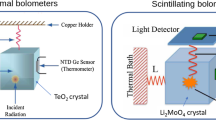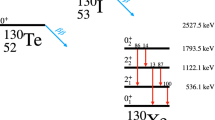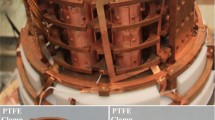Abstract
The CUPID-Mo experiment, located in the Laboratoire Souterrain de Modane (France), is a demonstrator for the next generation ton-scale bolometric neutrinoless double beta decay experiment CUPID. CUPID-Mo is composed of 20 Li\({}_{2}^{100}\)MoO\({}_{4}\) scintillating bolometers, searching for \(0\nu\beta\beta\) of \({}^{100}\)Mo. With about one year of data acquisition we set a world leading limit on the half-life of \(0\nu\beta\beta\) decay in \({}^{100}\)Mo of \(T_{1/2}>1.8\times 10^{24}\) yr at 90\(\%\) C.I. This limit corresponds to an effective Majorana mass \(m_{\beta\beta}<(0.28{-}0.49)\) eV, dependent on the nuclear matrix element in the light Majorana neutrino exchange interpretation.
Similar content being viewed by others
Avoid common mistakes on your manuscript.
1 INTRODUCTION
The search for \(0\nu\beta\beta\) is the best way to access the nature of neutrinos. This process is a nuclear transition where an even-even nucleus decays by emitting two electrons and no other particles. This implies a violation of the lepton number conservation by two units and that neutrinos are Majorana particles. Different mechanisms can explain this decay, the exchange of a virtual light Majorana neutrino represents a minimal extension of the Standard Model. In this mechanism, the \(0\nu\beta\beta\) rate is proportional to the square of the effective Majorana mass \(m_{\beta\beta}\), that is a linear combination of the three neutrino mass eigenstates.
2 EXPERIMENTAL PRINCIPLE
The signal of \(0\nu\beta\beta\) is a peak, in the sum energy spectrum of the two electrons, at the \(Q_{\beta\beta}\). Scintillating bolometers are crystals, cool down to very low temperature (<20 mK), that contains the \(0\nu\beta\beta\) source and are coupled to a temperature sensor. The signal consist of a dual readout of a thermal pulse and scintillation light detected by a light detector operated as a bolometer. This dual readout allows discrimination of \(\alpha\) particles from \(\beta/\gamma\) particles. The CUPID-Mo experiment studies the \(0\nu\beta\beta\) of \({}^{100}\)Mo with a \(Q_{\beta\beta}\) of \((3034.40\pm 0.17)\) keV. The experiment is installed at Laboratoire Souterrain de Modane (France), in the EDELWEISS cryostat. The CUPID-Mo experiment consists of 20–210 g Li\({}_{2}^{100}\)MoO\({}_{4}\) crystals enriched to \(\sim 97\%\) in \({}^{100}\)Mo, for a total mass of 2.26 kg of \({}^{100}\)Mo. The detectors modules are arranged into 5 towers of 4 modules, where each module consists of one crystal and one Ge light detector below it [1]. Data was acquired between March 2019 and July 2020, the detectors were operated at 20–22 mK with a total exposure of 2.71 kg year. The data analysis for the search of \(0\nu\beta\beta\) was done with a blinding strategy, removing all events in a \(\pm 50\) keV region around the \(Q_{\beta\beta}\).
3 RESULTS
Background model CUPID-Mo simulations are done with a Geant4 based program. Decays of the uranium and the thorium chain, or other nuclei are generated in all the different components of the experiment with detector effects convolved into Monte Carlo spectra. We performed a global fit of the data with the MC simulations with a Bayesian approach using Just Another Gibbs Sampler (JAGS). The result of the fit is a background index of \(\sim\)3 \(\times 10^{-3}\) ckky in a window of 15 keV around the \(Q_{\beta\beta}\).
\(0\nu\beta\beta\) The half life on the \(0\nu\beta\beta\) was extracted with a Bayesian counting analysis. When unblinding no events was found in the region of interest. This leads to a limit of \(T_{1/2}>1.8\times 10^{24}\) yr at 90\(\%\) C.I. on the \(0\nu\beta\beta\) half life of the \({}^{100}\)Mo [2].
4 CONCLUSIONS
CUPID-Mo experiment took data between March 2019 and July 2020. It has successfully demonstrated the maturity of the technology for the next generation ton-scale bolometric \(0\nu\beta\beta\) experiment CUPID. We set a world leading limit on the \(0\nu\beta\beta\) of \({}^{100}\)Mo, with an exposure of 1.21 kg year of \({}^{100}\)Mo, of \(T_{1/2}>1.8\times 10^{24}\) yr (90\(\%\) C.I.). This corresponds to the 4th most stringent limit on the effective Majorana mass that is \(m_{\beta\beta}<(0.28{-}0.49)\) eV.
REFERENCES
E. Armengaud et al., Eur. Phys. J. C 80, 44 (2020).
B. Welliver, Talk given at the 17th International Conference on Topics in Astroparticle and Underground Physics TAUP 2021. https://indico.ific.uv.es/event/6178/contributions/ 15722/.
Author information
Authors and Affiliations
Consortia
Corresponding author
Ethics declarations
The author declares that he has no conflicts of interest.
About this article
Cite this article
Imbert, L., CUPID-Mo Collaboration. CUPID-Mo: A World Leading Limit on Neutrinoless Double Beta Decay of \({}^{\mathbf{100}}\)Mo. Moscow Univ. Phys. 77, 369–370 (2022). https://doi.org/10.3103/S0027134922020436
Received:
Published:
Issue Date:
DOI: https://doi.org/10.3103/S0027134922020436




